
Artist unknown, The Old Abbey, Saarland, Germany, nineteenth century. Oil on canvas. (Courtesy, Keramikmuseum Mettlach.) This nineteenth-century oil painting illustrates the Old Abbey, which today houses the head administrative offices of Villeroy and Boch Company, its exhibition and salesrooms, and the historical displays of its Keramikmuseum.

Unknown artist, Eugen von Boch (1809–1898), undated. Oil on linen. (Collection of Wendelin von Boch-Galhau.) Boch was responsible for the creation of the Keramikmuseum in Mettlach around 1844.

Isaac Jacob (“Jake”) Gold, ca. 1870. (Photo courtesy of Ken Horner.) Born in New York, Gold moved with his family to Santa Fe when he was about nine years old.
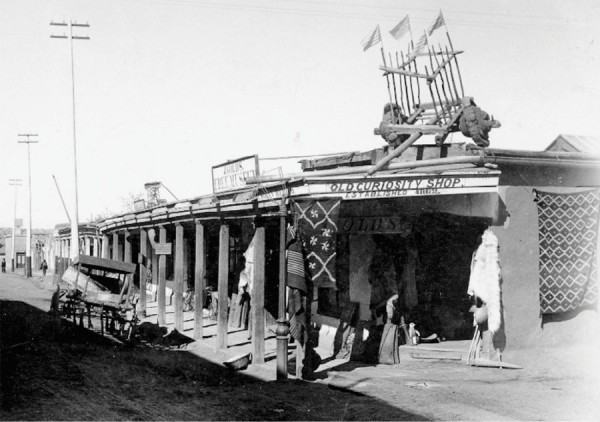
Jake Gold’s Old Curiosity Shop and Free Museum, Santa Fe, New Mexico, ca. 1895. (Courtesy, Palace of the Governors Photo Archives [NMHM/ DCA], 011338; photo, William E. Hook.) The shop was located at the corner of West San Francisco Street and Burro Alley, where Gold’s brother Aaron had run a business with food, drygoods, and other merchandise to sell or trade for Native American wares.
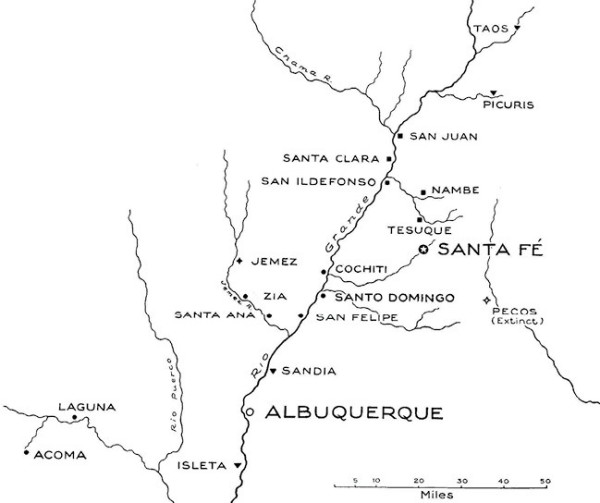
Map of a portion of northern New Mexico showing the locations of the sixteen pottery-producing Eastern Pueblos in the Rio Grande Valley, as well as two of the four Western Pueblos: Acoma and Laguna. Farther to the west are the Zuni Pueblo and, in Arizona, the Hopis. (Map by Charlotte Jacob-Hanson.)
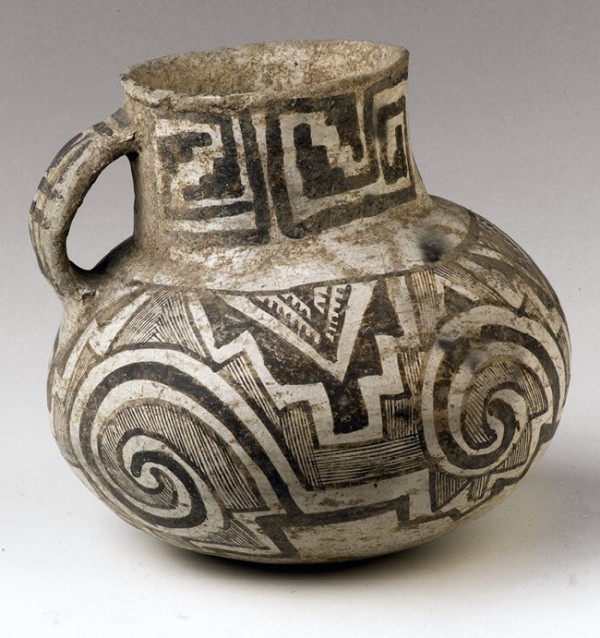
Jug, Tularosa black-on-white, Ancestral Pueblo: Southern Colorado Plateau (Anasazi), ca. 1175–1300. Earthenware. H. 10". (Courtesy, Keramikmuseum Mettlach 146/555.) This jug is decorated with a spiral-and-stepped design with solid and hatched fill.
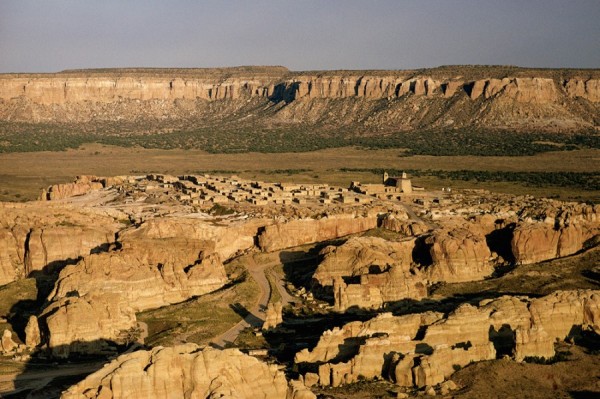
Aerial view over the village of Acoma Pueblo, in rocky landscape at dusk, New Mexico, United States, 2007. (Alamy Limited; photo, Adam Woolfitt.)
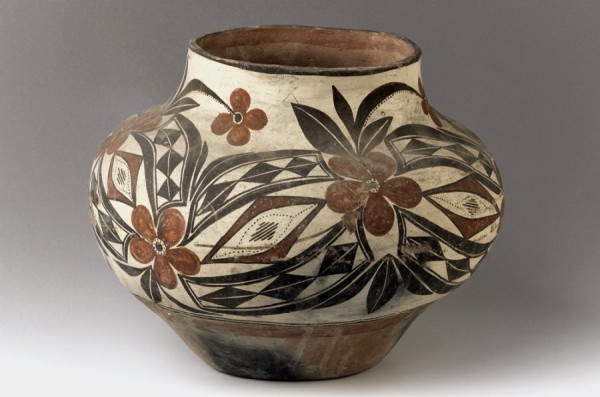
Water jar (olla), Acoma Pueblo, New Mexico, 1880–1890. Earthenware. H. 10". (Courtesy, Keramikmuseum Mettlach 117/526.) A polychrome-decorated olla with rounded shoulder and raised tapering neck, black on the rim and body with split leaves, diamonds, and flowers on a cream slip; black “fire cloud” on the lower portion.

Canteen, Acoma Pueblo, New Mexico, 1880–1890. Earthenware. H. 9 3/8". (Courtesy, Keramikmuseum Mettlach 118/527.) An Acoma pueblo polychrome canteen, with white clay and slip, painted with typical Acoma design elements in red and black: open ellipses, split parallelograms, and double dots (rain symbols).
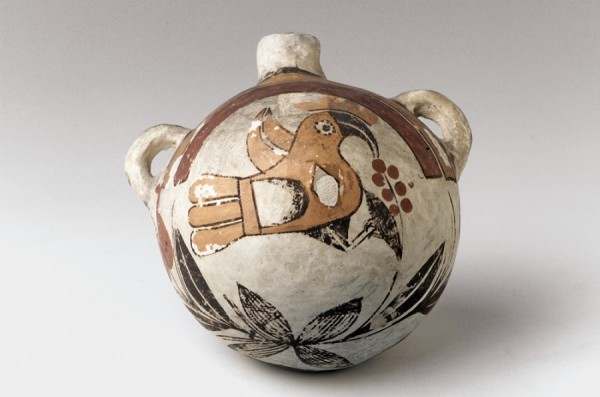
Canteen, Acoma Pueblo, New Mexico, 1880–1890. Earthenware. H. 6 1/8". (Courtesy, Keramikmuseum Mettlach 119/528.) An Acoma pueblo polychrome canteen, white clay and slip, featuring a typical Acoma macaw parrot and black split leaves with an arc-like rainbow above the bird.
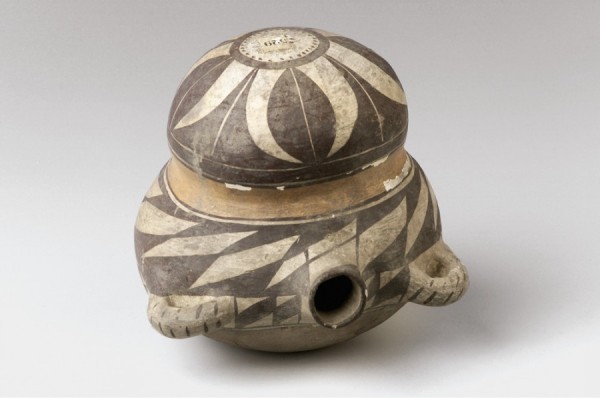
Canteen, Laguna or Acoma Pueblo, New Mexico, 1880–1890. Earthenware. H. 5 5/8". (Courtesy, Keramikmuseum Mettlach 120/529.) This unusually shaped canteen, possibly imitating the shape of a gourd, has decoration consisting of abstract leaves and parallelograms on two sections divided by a band in deep orange; the base is also colored in deep orange.

Canteen, Laguna Pueblo, New Mexico, 1880–1890. Earthenware. L. 12 1/2". (Courtesy, Keramikmuseum Mettlach 136/545.) This polychrome triple-chamber canteen, made of white clay, is decorated with large split-leaf petals outlined in brown on the outer sections and an ornament of split leaves in black painted in the center.

Bird effigy vessel, Acoma Pueblo, New Mexico, 1880–1890. Earthenware. H. 4 3/4". (Courtesy, Keramikmuseum Mettlach 123/532.) Archaeologists refer to this type of vessel as a “zoomorphic canteen.”

Double-headed bird effigy vessel, Laguna or Acoma Pueblo, New Mexico, 1875–1890. Earthenware. H. 4 1/4". (Courtesy, Keramikmuseum Mettlach 124/533.)
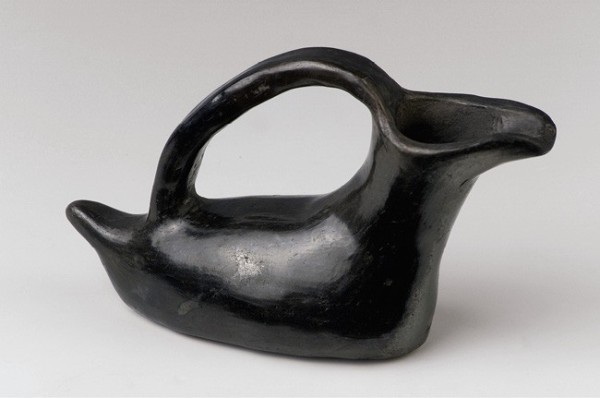
Bird-shaped pitcher, Santa Clara Pueblo, New Mexico, 1880–1890. Earthenware. H. 7 3/8” (Courtesy, Keramikmuseum Mettlach 150/559.) The shape of this blackware pitcher, with handle attached to the head and tail, possibly imitates a duck.

Three “idols” (rain gods), Tesuque Pueblo, New Mexico, ca. 1890. Earthenware. H. 6". (Courtesy, Keramikmuseum Mettlach 138/547, 139/548, and 140/549.) The center example is covered with a micaceous clay slip.

Three “idols” (rain gods), Tesuque Pueblo, New Mexico, ca. 1890. Earthenware. H. 6". (Courtesy, Keramikmuseum Mettlach 138/547, 139/548, and 140/549.) The center example is covered with a micaceous clay slip.
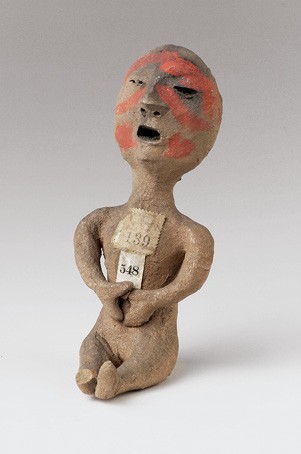
Three “idols” (rain gods), Tesuque Pueblo, New Mexico, ca. 1890. Earthenware. H. 6". (Courtesy, Keramikmuseum Mettlach 138/547, 139/548, and 140/549.) The center example is covered with a micaceous clay slip.

Three “idols” (rain gods), Tesuque Pueblo, New Mexico, ca. 1890. Earthenware. H. 6". (Courtesy, Keramikmuseum Mettlach 138/547, 139/548, and 140/549.) The center example is covered with a micaceous clay slip.

Standing figure, Cochiti Pueblo, New Mexico, 1875–1885. Earthenware. H. 12 1/4". (Courtesy, Keramikmuseum Mettlach 143/552.) A male figure with head tilted back and mouth open, arms akimbo, wearing painted vest and cowboy attire.
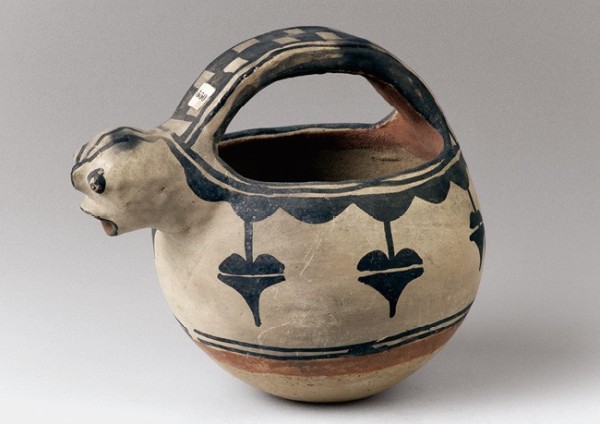
Effigy vessel, Cochiti Pueblo, New Mexico, 1880–1890. Earthenware. H. 7 1/8". (Courtesy, Keramikmuseum Mettlach 141/550.) This vessel, with painted decoration in black and red, was made for the tourist market.
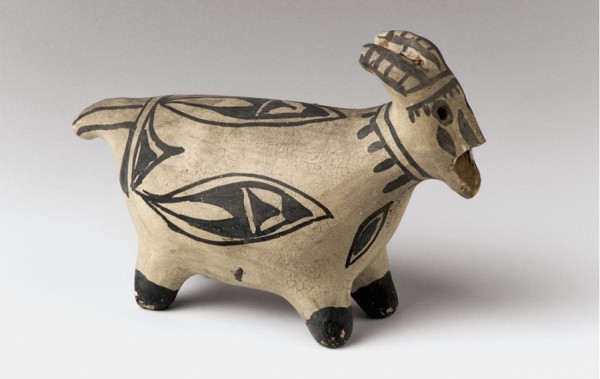
Figure of a goat, Cochiti Pueblo, New Mexico, 1880–1890. Earthenware. H. 4 3/4". (Courtesy, Keramikmuseum Mettlach 142/551.) This object was made specifically for the tourist market.
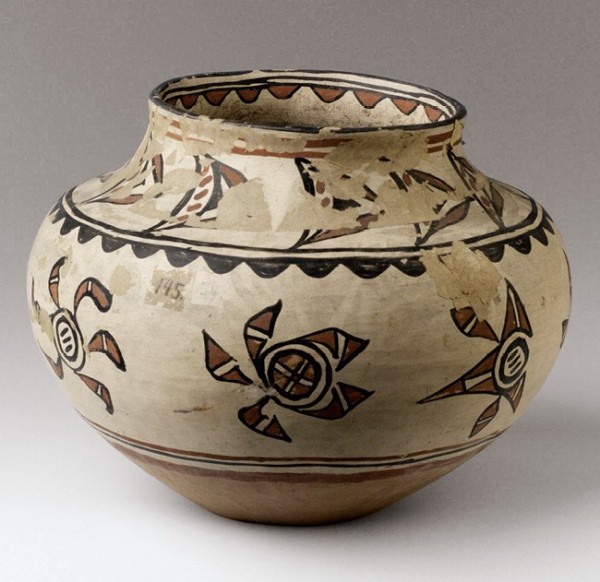
Water jar (olla), San Ildefonso Pueblo, New Mexico, 1880–1890. Earthenware. H. 7 1/4". (Courtesy, Keramikmuseum Mettlach 145/554.) This polychrome olla is decorated with swirling sun symbols, somewhat resembling pinwheels, beneath a scalloped band. This piece was listed as a “San Ildefonso Olla—Speisetopf.”
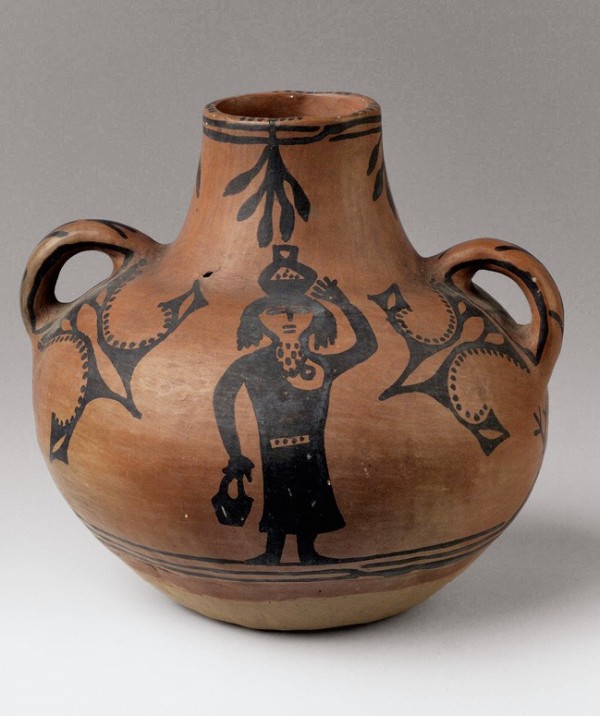
Water jar (olla), San Ildefonso Pueblo, New Mexico, 1880–1890. Earthenware. H. 8 1/4". (Courtesy, Keramikmuseum Mettlach 135/554.) This jar has polished red slip and black decoration (black-on-red), depicting a female figure in a non-Native dress balancing a vessel on her head with a stylized bird symbol on either side.
